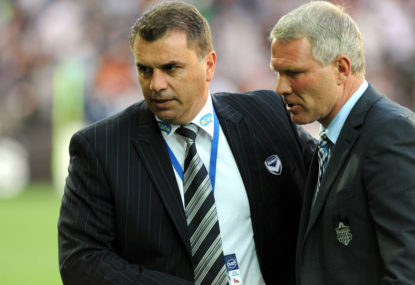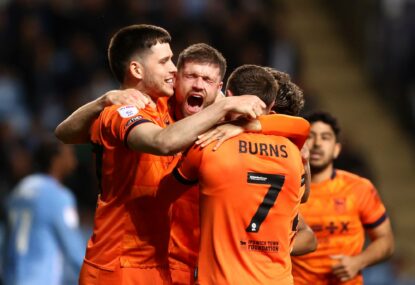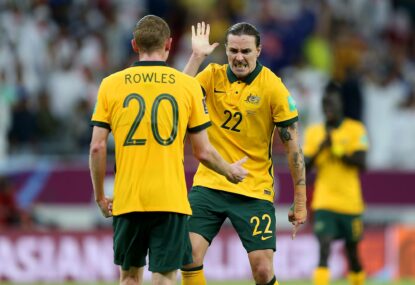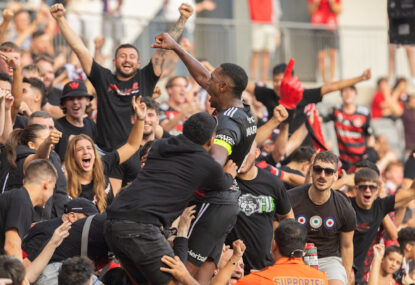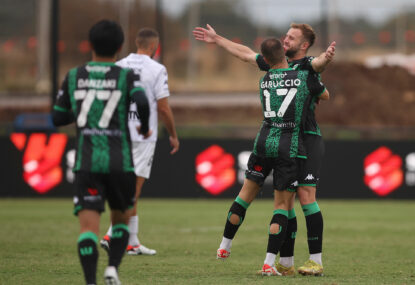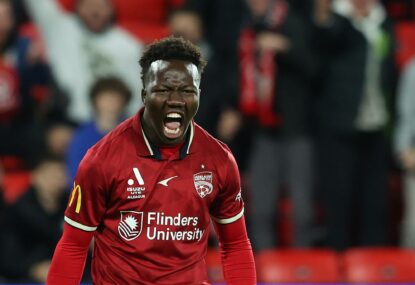In the deliberations that led to and since the appointment of Ange Postecoglou as Socceroos manager, much attention has been given to what needs to be the benchmark for the national team – both immediately and in the medium-term future.
While opinions differ slightly from commentator to commentator, Ange’s five-year contract tends to affirm the view that his role is to perform adequately in both the 2014 World Cup and 2015 Asian Cup, while also building the squad for the 2018 World Cup qualification and finals cycle.
The key point of debate focuses on just what constitutes ‘adequate’ in each of those tournaments.
In the 2014 World Cup, for example, the general view seems to range from ‘providing experience to youngsters and not being embarrassed’ to ‘being competitive and matching the performances of 2010’.
Really, though, these are far too hard to measure.
If we drew a group of death against Spain, France and Chile, would it be embarrassing to lose all our games 2-0? Conversely, if we drew a soft group of Switzerland, Iceland and Burkina Faso, would a narrow win, a heavy loss and a draw be considered competitive?
If the FFA is trying to give Ange Postecoglou some clear and assessable direction, the following might be most in line with the needs of the Australian public of their national football team:
Squad regeneration
It’s as though Australia has spent the seven years since the ‘golden generation’ of 2006 were narrowly edged out by Italy debating how we are going to replace them.
The end result seems to be that we still haven’t, with five of those in that starting XI still key members of the current squad.
I personally have debated in the past a key reason for this is a ‘lost generation’ of footballers aged 25-30 who in their key teenage developmental years were faced with the reality 10 years ago of a dying NSL, a national team that couldn’t qualify for a World Cup and a national body that was all but bankrupt.
The hopeless state of the game before Frank Lowy’s revolution is a very real reason a number of would-be stars might have quit the game altogether to pursue other interests.
Regardless of that, Australia has a number of talented players in their early 20s who need to be trusted to take us beyond the immediate future.
Holger Osieck took steps to inject the likes of Tommy Oar, Tom Rogic, Mitch Langerak, Rhys Williams and Robbie Kruse into the squad but rarely trusted them to start games.
However he also failed to provide sufficient opportunities for a number of other youngsters such as Shane Lowry, Trent Sainsbury, Eli Babalj, Jason Davidson and Adam Sarota.
Most disturbingly, Osieck tended to trust not only the ageing legs of the golden generation but also a number of middling players such as Alex Brosque, David Carney, Jade North, Matt McKay and Brett Holman, who have done very little of significance since 2011 and aren’t so young that we could expect them to still be national team players in 2014.
If Postecoglou decides keeping the older heads like Tim Cahill, Mark Schwarzer and Mark Bresciano around because they genuinely are the best Australia has going in to the 2014 World Cup, then he should be permitted to make that assessment, but in the 23-man squad going into the tournament a minimum of eight players (one-third of the squad) need to be picked with a view that they will form the core of a competitive 2018 World Cup team.
That would still allow Australia to put out as a strong a team as possible during the 2014 tournament, but also provide a large number of players the experience of being at and to varying extents playing on the big stage.
2014 World Cup
The most immediate concern for Ange Postecoglou is taking the wreckage of a shaky qualification campaign and the two recent embarrassing friendly losses and putting together a team to represent Australia a World Cup just eight months away.
Everyone wants Australia to do well at the tournament, but while some would happily sacrifice our chances to provide experience to those who’ll be likely to still be around by 2018, others would prefer we pick our best squad available regardless of age and the future.
In reality, just as with any nation at any tournament, a balance is what’s really required.
Results-wise, a simple and reasonable measurable for what’s likely to be a difficult World Cup would be to win a game regardless of what group we get.
With the entire nation, beyond the more dedicated football fans, uniting behind the sport during the World Cup, failing to win in three matches would severely harm the ability to harvest goodwill from those outside the game.
Ange has to go to the tournament expecting we will beat at least one of whichever three teams we have to play.
2015 Asian Cup
Just a year after the World Cup, Australia will play host to Asia in the second-biggest tournament the Socceroos play in.
This is set to be a defining tournament for the game in Australia, and underperforming here should not be tolerated.
As such, it would be unreasonable to rule a line through players who might’ve been in our best team in 2014 but are likely to be too old by 2018.
Postecoglou needs to pick a squad for this tournament that builds on the youth injection for the 2014 World Cup, but still allows him to pick the best XI players Australia has to offer.
Assuming a number of youngsters will have pushed their names towards the top of the teamsheet based on 2014 World Cup performances, the squad here should feature no more than eight players (one-third of the squad) who aren’t likely to feature in the 2018 World Cup finals.
Basically, any player over 31 in 2015 should be getting the tap on the shoulder to say either their time has come or will be coming at the end of the Asian Cup.
The minimum result should be a semi-final appearance. Anything less than ranking in the top four teams in Asia should be considered a failed tournament.
Further, we should expect to not get beaten by any teams ranked lower in the FIFA World Rankings than us in a tournament on home soil.
A semi-final loss to Japan would be acceptable, but a home loss to a Qatar, Uzbekistan or Jordan would have to call into question whether Postecoglou has the team performing as required.
2018 World Cup
Australians are getting used to their team playing in the World Cup finals, and of course getting us qualified is the foremost job of whoever is managing the team.
Given the weeding-out of the elder statesmen will have already largely been conducted over the two previous tournaments, Postecoglou should have a group of youngsters with the confidence and experience to lead the way in qualifying for the Russian edition of the event.
Postecoglou, however, hasn’t been appointed now with a five year contract because we just want to qualify for the 2018 World Cup.
Giving a coach that amount of time is a clear sign Australia needs to actually perform at the finals.
The fruits of Postecoglou’s work and the vindication of the decision taken in the wake of the recent results will be seeing Australia exceed the golden generation and qualify for a World Cup quarter final.
World Cup quarter finals aren’t easy to make – typically they require either beating a top-seeded nation in the group stage to top the group or beating a top-seeded nation in the second round.
But Australians want to be able to see their team beating the best, and by 2018 simply qualifying should no longer be enough.
At World Cup finals we’ve beaten Japan and Serbia, but eventually we need to be able to say we’ve beaten a Brazil or Argentina or Spain.
And if we can do that, who knows?
Maybe Postecoglou will be given an eight-year contract extension, with a view to building a team that can go to the 2026 World Cup and win the thing!






























































































